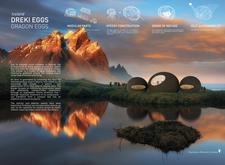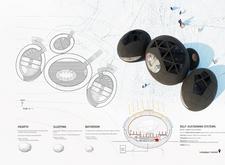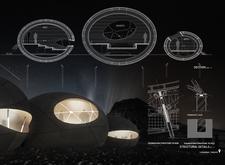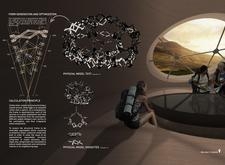5 key facts about this project
At its core, the project functions as a multi-purpose facility, designed to serve various community needs. The layout is carefully organized, allowing for smooth circulation and accessibility. Key public areas, such as community meeting rooms and flexible event spaces, are strategically placed to encourage social interaction and engagement among users. The design reflects a commitment to inclusivity, providing spaces that cater to diverse groups and activities.
The materiality of the project is particularly noteworthy, employing a palette that speaks to both durability and sustainability. Preferred materials include concrete, glass, reclaimed wood, and metal, each selected not only for its structural properties but also for its aesthetic qualities. The use of glass allows for ample natural light to penetrate the interior spaces, fostering a sense of openness while also blurring the boundaries between indoors and outdoors. Reclaimed wood elements contribute warmth and character, connecting the structure to local craftsmanship and heritage.
Design elements manifest throughout the project, showcasing unique approaches to sustainability and environmental mindfulness. Green roofs and vertical gardens are incorporated into the design, providing not only aesthetic value but also improving air quality and promoting biodiversity. These biophilic design strategies are key in creating a space that is not just a building, but a vital part of the ecological framework.
The architectural plans detail a well-thought-out spatial organization, where every area has a purpose and is designed with user experience in mind. The open floor plan fosters collaboration, while carefully designated quiet spaces allow for reflection and individual work. Architectural sections reveal the thoughtful stratification of spaces, from high-ceiling communal areas to intimate alcoves, ensuring that users have access to a variety of environments suited to different activities.
The roofline of the project exhibits a unique, undulating form that responds to the local topography, while also providing practical advantages such as rainwater harvesting, enhancing the building’s sustainability credentials. This innovative approach distinguishes the project, making it a noteworthy example of contemporary architecture that prioritizes user comfort and environmental responsibility.
In terms of architectural ideas, the project embodies a modern interpretation of traditional forms, bridging the gap between historical context and forward-thinking design. The incorporation of local cultural references within the architectural language introduces a sense of place and identity. The use of color and texture serves not only as a visual appeal but also as a meaningful representation of the community it serves.
For those interested in further exploring the intricacies of this architectural design, a comprehensive presentation provides detailed architectural plans, sections, and designs that illuminate the thought processes behind each decision. By delving into these resources, readers can gain deeper insights into how the interplay of architecture, functionality, and environment shapes the final design outcomes. This project stands as an invitation to engage with architecture that respects its context and enriches the lives of its users.


























